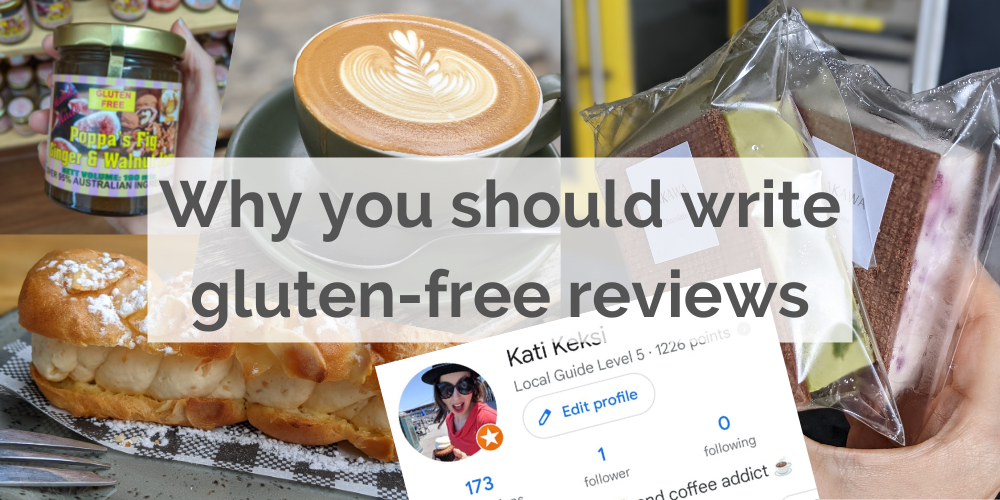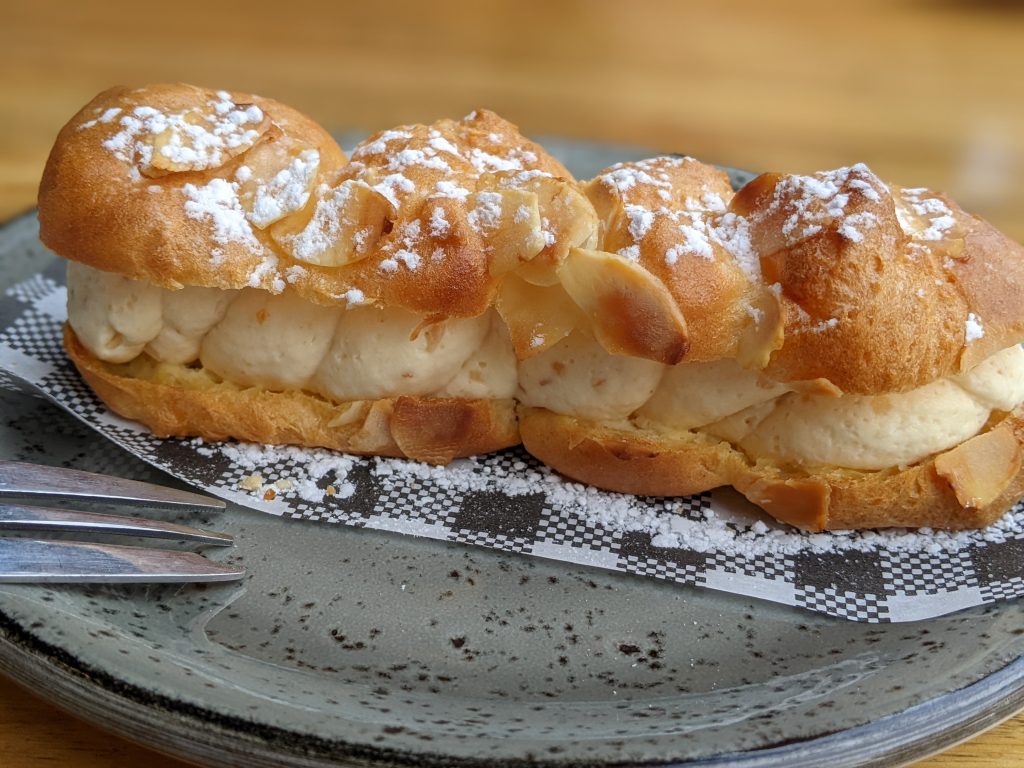Six reasons why you should write reviews

Posted: March 2, 2022 Updated: October 19, 2024
I started to write reviews highlighting gluten-free options at the start of 2022. I soon realised that while a lot of people write reviews, they don’t do it consistently.
Surprisingly there are not many posts on why you should write reviews. So that is what I’m doing here today.
Note: while this is written from a gluten-free perspective it relates well to any dietary niche and overall advice on how to write useful reviews.
You use reviews more than you think
Reviews are something we use every day, sometimes without even realising. Think of the last time you looked for nearby coffee, did you pick the place that was 4.3 stars or the one that was 2.7?
Using a simple numeric value is a quick way to assess what is best for us in situations where we are sometimes overloaded with information.
I use reviews on Google Maps a lot, most commonly for coffee. First, it’s a rating of the venue, usually four stars or higher.
Next I look at the photos of the coffee, looking for the tell-tale signs of a skilled barista. If I see a really good looking coffee in the photo then I’m convinced it’s worth visiting.

When it comes to finding gluten-free food on Google Maps it’s a little bit more complicated. Google Maps looks at the website of the venue to see if gluten-free options are available.
It’s run by a script (a computer) so all it’s looking for is the words ‘gluten free.’ You could end up with a positive result but the website actually says “We don’t do gluten free, go away”!
After this, the script looks at reviews – real customers who have been to the venue and seen or experienced what is on offer. I think about half the time I see gluten free mentioned in a review it’s a professional reviewer who isn’t gluten free.
These are common on brunch venues, they give a massively detailed review on what they ate. Then in their summary mention opening hours and dietary catering etc. So what they see as great gluten-free options might just be a single salad and a stale slice of orange and almond cake. 🤦♀️
You can offer a gluten-free or coeliac perspective
The other reviews I see are from people who eat gluten free all the time. I get a boost when I see a review like this because I know I could be on to a winner.
Coeliac reviewers in particular will sometimes share the conversations they’ve had with staff. Information such as their knowledge on cross contact, the use of separate fryers or the storage of their products.
All these details help to paint a picture of what a venue is like to eat in when you’ve got a dietary requirement. It’s the kind of detail that doesn’t fit on a menu or come across in a photo.
If you use reviews, you need to write reviews
Even when I’m buying a coffee I’ll take a look at the cake / treats section and see what’s on offer. Although I’m not always buying cake I can still list what is available. I can make a comment on storage too, here’s a note from a recent review.
“One gluten free cake, one cookie and an energy ball, however the cake is stored next to the regular cakes and only one set of utensils was seen so there could be a cross-contact risk.”
This way, those that are concerned about cross contact can keep this in mind when making a decision about ordering a cake.
It is a fascinating thing, what you can notice while waiting for your drink to be made. I once saw gluten-free cakes being stored in the same container as croissants! I mean that just doesn’t make sense for any reason.
You can help businesses understand that gluten-free and other dietary requirements are more than just a label
The attitude from store to store and country to country towards gluten-free options and dietary requirements varies widely.
In Finland for example 80% of menus are labelled with a G for gluten free (gluteeniton) or an L for lactose free (laktoositon).
In cafes I often saw gluten-free cakes in a separate part of the display fridge with a dedicated pair of tongs stored nearby. When I ordered from restaurants and asked for gluten free I’d often receive follow-up questions – particularly if shared fryer was being used.
Although I haven’t eaten out a lot in Australia since returning I can’t say there’s the same level of detail here. Often when I’m at a cafe waiting for a coffee I’ll see just one pair of tongs for the 10 different cakes on display. As a friend said to me recently, “Gluten aside that’s just gross, I don’t want lemon cake crumbs on my chocolate tart.”
Politely noting in a review that only one set of tongs were observed is a totally reasonable thing to do.
You can support the gluten-free community
Writing reviews highlighting gluten-free options and service gives back to the gluten-free and coeliac community.
While a good review on Instagram reaches a dedicated audience your review on Maps for example will reach thousands more.
I started writing reviews on Google Maps in January 2022 and in just a month I’d written 45 reviews which had been viewed a total of 4,300 times. I had 35,000 views on the 95 photos I’ve uploaded – three of which had 2,000 views each (one gf cake, and two separate coffees).
Google Maps has some elements of gamification. I’m now a Level 8 Local Guide.
It doesn’t give me anything special, but it is kind of neat to see how my five minutes per review has been helpful to so many people. I also get a certain kick out of watching the number of views climb on my reviews and photos every day (as of May 2023 it’s 4.8 million). Update: October 2024, 17 million views.
You can promote gluten-free businesses outside of their normal clientele
More reviews and higher ratings make businesses appear higher in search results. While living in London I saw the closure of a number of dedicated gluten-free bakeries, cafes and restaurants. Unfortunately, it takes more than just the gluten-free community to keep these businesses going.
If your local gluten-free bakery does amazing coffee, write a review about it! It might mean folks who aren’t on a gluten-free diet flock there for coffee, which will in turn help sustain the business. Hey, they might even buy a cake for their coeliac cousin they’re visiting tomorrow.
The non-gluten free seal of approval.
You see it in Instagram posts and reviews often, and for good reason. Gluten-free products can often be, let’s face it, crap. Dry, crumbly and flavourless.
So when a good product comes along and you’re sharing it with your wheat-guzzling friend / partner / family member and they say, “Yeah, this is pretty good, I’d eat it again.” It’s a revelation. It passed the wheat-eater test.
Comments like this in a review do genuinely help attract customers, I should know – I’ve dragged many friends across cities to go to gluten-free restaurants.
There’s often the pleasant surprise of, “Oh I couldn’t even tell this was gluten free.” Perfect.

You can give back the things you appreciate
Remember how I said I make my coffee decisions based on photos of the coffee? Well, I now ensure I upload a photo of my coffee every time I review. This way people who think like me have the information they need to choose a cafe.
This expands way further though, say you need gluten free and vegan, gluten free and dairy free, gluten free and low FODMAP. All these are key examples of what is super useful to include in your review. If you write reviews like this it will encourage others to do the same.
Some examples to that might be worth highlighting
- Clear labelling on menus
- Recent changes to menus – this is a big one, I’ve turned up to cafes only to find the menu has changed in the last six months and the GF menu items are gone!
- Willingness to adapt menu items
- Politeness of staff when fielding questions
- Allergy awareness from staff (i.e. they don’t start talking about vegan options when you mention gluten free)
- Dedicated fryer for chips
Even one review makes a difference
Thanks for reading this far, I hope I’ve inspired you to leave some reviews on your favourite or perhaps least favourite restaurants and venues.
Just one review could mean a huge deal to another person searching, or a small business trying to stay afloat.
A quick summary of my post is below.
When you write reviews you can
- Offer a coeliac perspective
- Provide more detail than just the amazing and the awful
- Give back the things you appreciate
- Build a sense of community
- Make store owners realise that dietary needs matter
- Showcase your favourite places
- Highlight how good gluten-free venues are for regular folk
This is such good information Kati! Coeliacs should be more active and give more feedback since that will help us coeliacs in the long run. I will keep this in mind.